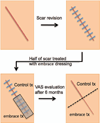The embrace device significantly decreases scarring following scar revision surgery in a randomized controlled trial
- PMID: 24105084
- PMCID: PMC4874339
- DOI: 10.1097/01.prs.0000436526.64046.d0
The embrace device significantly decreases scarring following scar revision surgery in a randomized controlled trial
Abstract
Background: Mechanically offloading or shielding an incision significantly reduces scarring in both animal and first-in-human studies. Whether or not this strategy would be effective following scar revision surgery was previously unknown. In this article, the authors report that the embrace device, which uses principles of mechanomodulation, significantly improves aesthetic outcomes following scar revision surgery.
Methods: A prospective, open-label, randomized, single-center study was conducted to evaluate the appearance of scars following revision and embrace treatment. Revision surgery was performed on 12 patients, each acting as his or her own control, and outcomes were assessed at 6 months. A visual analogue scale was used to evaluate each scar, rated by four independent surgeons who were not involved in the study.
Results: Evaluation of 6-month scar images by four independent surgeons using the visual analogue scale demonstrated a highly significant improvement in scar appearance following embrace treatment (p < 0.005).
Conclusion: The embrace device represents a powerful new technology for significantly improving scar appearance following revision surgery.
Clinical question/level of evidence: Therapeutic, II.
Figures






Comment in
-
Discussion: the embrace device significantly decreases scarring following scar revision surgery in a randomized controlled trial.Plast Reconstr Surg. 2014 Feb;133(2):406-407. doi: 10.1097/01.prs.0000436812.73412.a4. Plast Reconstr Surg. 2014. PMID: 24469172 No abstract available.
-
Tension shielding with the embrace device: does it really improve scars?Plast Reconstr Surg. 2014 Oct;134(4):662e-664e. doi: 10.1097/PRS.0000000000000568. Plast Reconstr Surg. 2014. PMID: 25357067 No abstract available.
-
Reply: tension shielding with the embrace device: does it really improve scars?Plast Reconstr Surg. 2014 Oct;134(4):664e-666e. doi: 10.1097/PRS.0000000000000560. Plast Reconstr Surg. 2014. PMID: 25357068 No abstract available.
References
-
- Gurtner GC, Werner S, Barrandon Y, Longaker MT. Wound repair and regeneration. Nature. 2008;453:314–321. - PubMed
-
- Thomas JR, Somenek M. Scar revision review. Arch Facial Plast Surg. 2012;14:162–174. - PubMed
-
- Shockley WW. Scar revision techniques: Z-plasty, w-plasty, and geometric broken line closure. Facial Plast Surg Clin North Am. 2011;19:455–463. - PubMed
-
- American Society of Plastic Surgeons. [Accessed March 5, 2013];2012 Report of the 2011 Statistics National Clearinghouse of Plastic Surgery Statistics. Available at: http://www.plasticsurgery.org/Documents/news-resources/statistics/2011-s....
Publication types
MeSH terms
Substances
Grants and funding
LinkOut - more resources
Full Text Sources
Other Literature Sources
Medical
Research Materials

